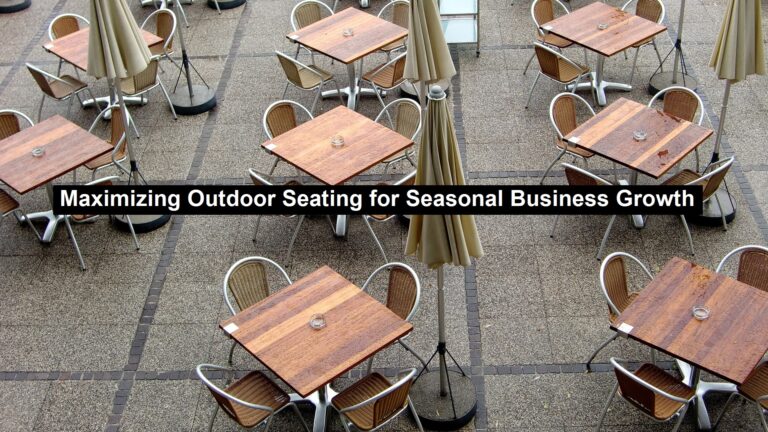For businesses that experience seasonal fluctuations, strategically maximizing outdoor seating can be a powerful way to boost revenue during peak times. Restaurants, cafes, and even retail stores can benefit from creating inviting outdoor spaces that encourage customers to stay longer, increasing both foot traffic and sales. Here’s how to make the most of outdoor seating for seasonal growth, along with some practical tips to get started.
1. Analyze Your Space and Needs
Before investing in outdoor seating, assess the layout of your available space. Consider the type of environment you want to create, as well as the practicalities. Are you looking to provide a spacious dining experience for customers, or is a cozy, intimate setting more appropriate? For businesses with limited outdoor areas, focus on seating that maximizes the number of guests without compromising comfort. Larger venues may have the flexibility to incorporate varied seating options, from communal tables to individual, quieter spots.
It’s also essential to keep seasonal variations in mind. For instance, warmer months may draw large crowds, necessitating additional tables and chairs. In colder seasons, modular furniture can allow for quick reconfiguration to create a more compact, comfortable setup that reduces empty-looking spaces.
2. Select the Right Furniture
Choosing the right outdoor furniture is essential for both comfort and functionality. Durable, weather-resistant materials such as metal, teak, or wicker are excellent options, as they withstand seasonal changes better than indoor furniture. High-quality outdoor seating not only enhances customer satisfaction but also minimizes maintenance needs, helping to keep costs down in the long run.
When selecting furniture, keep your brand’s aesthetic in mind. Stylish and cohesive seating that aligns with your brand can make a significant impact on customers’ impressions. For instance, a chic bistro may favor elegant wrought-iron tables, while a family-friendly cafe might go with colorful, easy-to-clean seating options. If you’re looking to buy outdoor furniture, ensure the pieces meet your business’s specific durability and design standards.
3. Create a Comfortable, Inviting Ambiance
A comfortable and visually appealing ambiance can turn a simple outdoor seating area into a customer magnet. To make outdoor spaces more inviting, consider adding shade solutions such as umbrellas, pergolas, or retractable awnings to protect guests from sun or light rain. This not only keeps customers comfortable but also extends the usability of your outdoor area across various weather conditions.
Lighting also plays a crucial role in creating an inviting outdoor environment. For evening hours, string lights, lanterns, or softly lit pathways can create a warm and welcoming atmosphere. Additional touches like potted plants, flower boxes, or even small water features can enhance the visual appeal, helping your business stand out in a competitive market.
Read: 3 Smart Strategies for Managing Debt Obligations
4. Optimize Seating for Customer Flow
Managing the flow of customers is essential to avoid congestion and maximize revenue. Arrange tables in a way that allows for easy movement of staff and customers. Consider group seating for larger parties, as this can encourage longer stays and higher spending. If your space permits, offering both communal tables and smaller tables can cater to diverse customer groups, from solo visitors to families or larger gatherings.
Maintaining flexibility in your seating arrangement is crucial, especially if you experience significant seasonal demand shifts. Stackable or foldable chairs, for example, can allow for quick setup or removal based on daily needs.
5. Leverage Outdoor Seating for Marketing
A well-designed outdoor seating area can double as an excellent marketing tool. Unique or visually pleasing setups can attract customers walking by and even lead to organic social media exposure. Customers love to share photos of unique experiences, so consider adding “Instagrammable” features like greenery walls, fun signage, or unique table settings.
Special events, seasonal themes, or promotional offers tied to outdoor seating can also draw attention. Host themed nights or pop-up events in your outdoor area to capitalize on peak seasonal interest. The outdoor setting can provide a fresh backdrop, encouraging both new and returning customers to visit and explore what’s new.
6. Adapt to Weather Changes with Seasonal Decor
Changing up the outdoor decor based on the season can give your business a fresh look and align with customer expectations. Consider decorating for holidays or using seasonal plants and flowers in your space. Seasonal furniture options, such as swapping out cushions or adding cozy blankets during cooler months, can enhance customer comfort and demonstrate attention to detail.
Outdoor seating provides a versatile opportunity for seasonal businesses to attract customers and increase revenue. By analyzing space, choosing the right furniture, and optimizing the ambiance, businesses can create outdoor spaces that maximize profitability during peak seasons. If you’re planning to buy outdoor furniture, prioritize durability, design, and comfort to set a solid foundation for success. With thoughtful planning, your outdoor area can become an invaluable asset that drives growth and enhances customer experience year-round.




